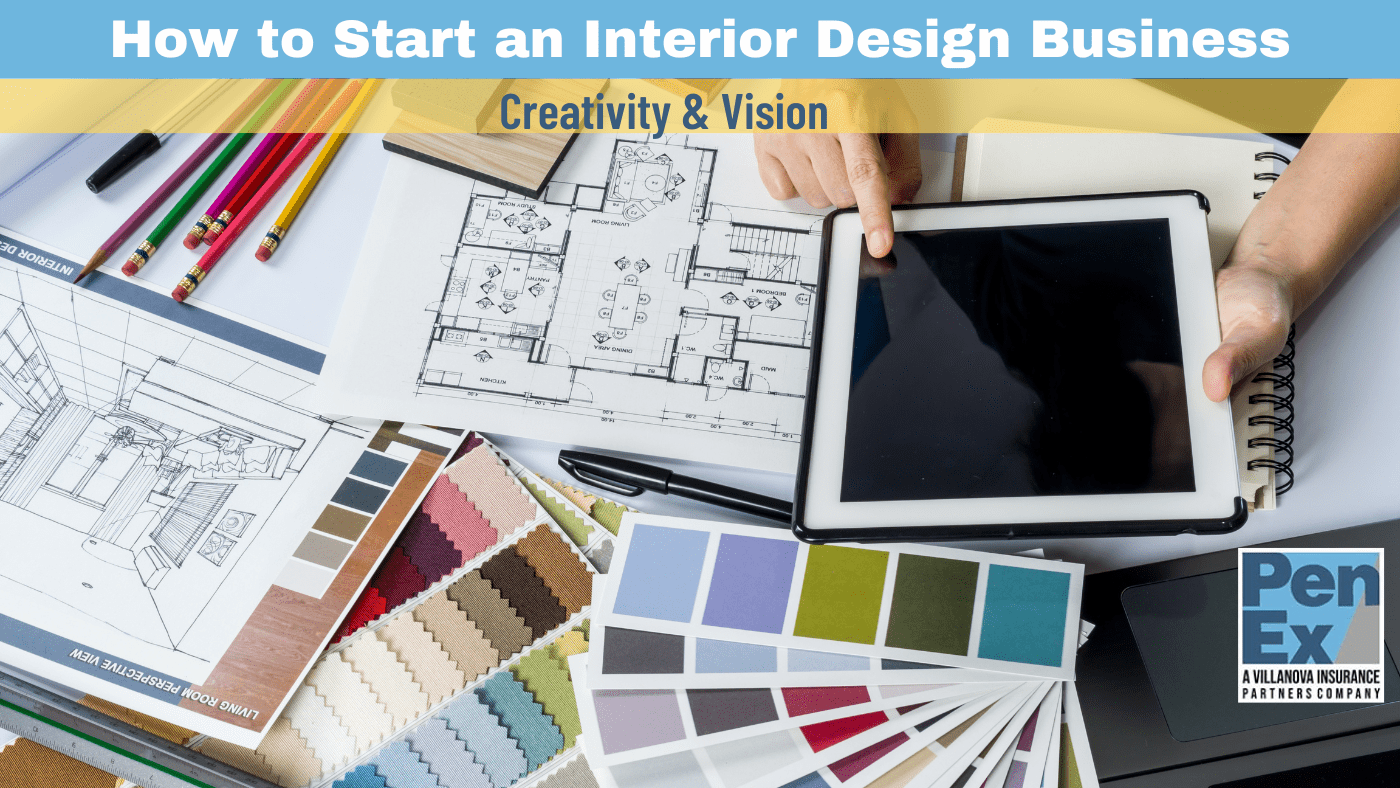The interior design industry is booming, fueled by home renovation shows and a growing desire for beautiful and functional living spaces. If you’ve ever dreamed of turning your passion for design into a career, now is a great time to get started. But before you dive in, careful planning is essential for success. Here are 10 steps to guide you on your journey to becoming a successful interior designer:
- Define Your Business Style & Specialty
- Develop Your Interior Design Skills
- Interior Designer Qualifications and Education
- Create A Business Plan For Your Interior Design Business
- Identify Your Target Market and Ideal Clients
- Develop a Marketing Plan For Your Interior Design Business
- Promote The Heck Of Your Interior Design Business Online
- Build The Brand Of Your Interior Design Business
- Business Networking and Building Relationships
- Stay Informed in the Latest Interior Design Trends
1. Define Your Business Style & Specialty
Your unique perspective and target audience are the cornerstones of your future business. Here are some key questions to ask yourself as you develop your niche:
- What services will you offer? Will you specialize in residential design, helping homeowners create dream kitchens, bathrooms, or living spaces? Or are you drawn to the commercial design world, crafting inspiring office environments or stylish restaurant interiors?
- Who is your ideal client? Do you see yourself working with young professionals creating their first apartment, or established families renovating their forever homes? Perhaps your passion lies in transforming commercial spaces, crafting modern offices or welcoming retail stores.
- What design style defines you? Are you drawn to the clean lines of modern minimalism, the timeless elegance of traditional design, or the eclectic charm of a bohemian aesthetic?
Knowing your niche will help you attract clients who resonate with your aesthetic and appreciate your unique approach to design.
2. Develop Your Interior Design Skills
While creativity and a strong sense of style are foundational for any aspiring interior designer, there’s more to the profession than meets the eye. To thrive in this field, you’ll need to cultivate a well-rounded skillset. Here are some key areas to focus on:
- Creativity and Vision: The ability to translate your client’s vision into a functional and beautiful space is paramount.
- Spatial Awareness: You’ll need a keen eye for how furniture and decor will function within a specific space, ensuring a comfortable and aesthetically pleasing flow.
- Understanding of Color and Texture: Mastering color theory and texture is essential to creating cohesive and visually interesting designs.
- Proficiency in Design Software: In today’s digital world, proficiency in programs like AutoCAD, Vectorworks, or Live Home 3D is a valuable asset.
- Communication Skills: Excellent communication is crucial for presenting your ideas to clients, collaborating with contractors and vendors, and ensuring everyone is on the same page throughout the project.
- Organizational Skills: Strong organizational skills will help you stay on schedule and budget, keeping your projects running smoothly.
Free Interior Design Business Insurance Quote
3. Interior Designer Qualifications and Education
Formal education and certifications can give you a competitive edge in the interior design industry. Here are some ways to bolster your qualifications:
- Education: While not always mandatory, earning an associate’s or bachelor’s degree in interior design will provide you with a solid foundation in design principles, building codes, construction documents, and business practices.
- Experience: Consider gaining practical experience through internships or entry-level jobs with established design firms. These experiences will allow you to hone your skills, build your portfolio, and gain valuable insights into the daily realities of the interior design profession.
- Certifications: If you’re serious about establishing yourself as a leader in the field, consider pursuing certifications like the National Council for Interior Design Qualification (NCIDQ) exam.
4. Create A Business Plan For Your Interior Design Business
A well-crafted business plan will serve as your blueprint for success, guiding your efforts and potentially helping you secure funding. Here are the mini-steps involved in creating a comprehensive business plan:
- Executive Summary: Briefly introduce your business, outlining your mission statement, target audience, and unique selling proposition.
- Company Description: Provide a more detailed overview of your services, business structure, and team (if applicable).
- Market Analysis: Define your target market and analyze the competitive landscape.
- Marketing Strategy: Outline your plan for reaching your target audience and building brand awareness. This might include online marketing strategies, social media presence, or participation in industry events.
- Financial Projections: Create a financial forecast that outlines your start-up costs, operational expenses, and projected revenue.
Business Considerations
- Business Structure: Choose a business structure that best suits your needs. Limited Liability Companies (LLCs) are a popular option for small businesses as they offer personal liability protection. You can find resources online or consult with an attorney to help you register your LLC and comply with state regulations.
- Business Permits and Licenses: Research any permits and licenses required to operate an interior design business in your area. Contact your local government or business development center for guidance.
- Insurance: Protect yourself and your business with appropriate insurance coverage. General liability insurance is essential, and you may also want to consider professional liability insurance (E&O insurance) specific to the design industry. PenEx offers a wide range of interior design insurance options and can help you choose the coverage that’s right for your business.
By taking the time to develop a detailed business plan, you’ll gain clarity on your vision and increase your chances of success.
Insure All Aspects of Your Interior Design Business
5. Identify Your Target Market and Ideal Clients
Understanding your target market is crucial for tailoring your marketing efforts and attracting the right clients. Will you focus on residential design, helping families create comfortable and stylish living spaces? Or perhaps your passion lies in commercial design, transforming office environments or retail stores. Go beyond simple demographics and delve into psychographics to understand your ideal client’s lifestyle, values, and design preferences. Focusing on a niche market allows you to become an expert in a specific area, attracting clients who appreciate your specialized knowledge and design approach.
6. Develop a Marketing Plan For Your Interior Design Business
Your marketing plan is the roadmap to getting your name out there and attracting your ideal clients. Align your strategy with your target market and budget. Here are a variety of marketing channels you can leverage:
- Online and Social Media Platforms: Create a strong online presence showcasing your design expertise. Develop engaging content for platforms like Facebook, Instagram, and Houzz. Utilize high-quality photos of your completed projects and behind-the-scenes glimpses of your design process.
- Designer Showrooms: Partner with local designer showrooms to display your work and connect with potential clients.
- Portfolio Website: A professional website is your digital storefront. Invest in a user-friendly website that highlights your services, showcases your portfolio with high-resolution images, and includes clear calls to action for potential clients to contact you.
- Industry Publications: Get your work featured in relevant design publications or online blogs. This can boost your credibility and reach a wider audience within the design community.
- Direct Mail/Email Marketing: Targeted email marketing campaigns can be a great way to nurture leads and stay connected with past clients.
- Referral Programs: Incentivize happy clients to refer their friends and family by offering referral programs.
Pursuing the best marketing avenue for needs requires daily attention and should be an integral part of your business plan and practice. At PenEx powered by villaNOVA Insurance Partners, we have an expert team to help you with any questions you may have. Contact us now to get started.
7. Promote The Heck Of Your Interior Design Business Online
In today’s digital world, a strong online presence is essential. Here are some key strategies to elevate your online visibility:
- Develop a User-friendly Website with a Portfolio
- Claim Your Google My Business Listing
- Utilize Google Ads for Targeted Keyword Campaigns
- Build Positive Online Reviews
- Engage on Social Media Platforms (Facebook, Instagram)
- Utilize Industry Lead Generation Websites
- Showcase Your Work on Pinterest
Interior designers can be sued, especially when it comes to contacts. Get a free PenEx insurance quote for your interior designer business coverage.
8. Build The Brand Of Your Interior Design Business
Your brand is more than just a logo; it’s the essence of your business. It encompasses your design philosophy, your attitude, and your unique selling proposition. Here’s how to cultivate a strong brand:
- Trademark Your Brand Name and Logo: Consider trademarking your business name and logo to protect your intellectual property. This will prevent others from using your brand identity without your permission. A trademark attorney can advise you on the trademarking process.
- Define Your Brand Identity: Consider what sets you apart from other interior designers. What is your design philosophy? What kind of experience do you want to create for your clients?
- Develop a Consistent Brand Voice: Maintain a consistent voice across all your communication channels, whether it’s your website, social media posts, or email marketing campaigns.
- Visual Identity: Develop a cohesive visual identity that includes your logo, color palette, and fonts. Ensure your visual identity reflects the overall brand personality you’ve defined.
- Incorporate Your Brand into Your Physical Workspace: If you have a physical workspace, incorporate your brand elements into the design to create a cohesive and inviting environment for clients.
Get More Information About How to Build Your Brand
9. Network and Build Relationships
Building strong relationships is vital for success in the interior design industry. These relationships can be a source of new clients, collaborations, and valuable industry knowledge.
Joining professional organizations like the American Society of Interior Designers (ASID) or the Interior Design Society (IDS) is a great way to connect with fellow designers, access educational resources, and participate in industry events. Attending industry events, trade shows, and conferences provides opportunities to connect with potential clients, vendors, and other design professionals. Expanding your network can also be achieved by collaborating with other creative professionals like architects, contractors, and furniture makers. These collaborations can open doors to new project opportunities and allow you to offer your clients a more comprehensive design experience.
10. Stay Informed in the Latest Interior Design Trends
The design industry is constantly evolving, and staying ahead of the curve is essential for maintaining a competitive edge. Ensure you’re continually developing your skills and knowledge by staying updated on design trends and immersing yourself in the ever-changing world of design. Subscribe to design publications, attend industry workshops, and follow design blogs and influencers. This constant exposure will keep you informed on the latest trends in materials, color palettes, furniture styles, and sustainable design practices.
Continue investing in your professional development by taking education courses and workshops to hone your existing skills and acquire new ones. This could involve learning new software programs, mastering specific design techniques, or deepening your understanding of building codes and construction principles.
Cultivate a curious mindset and embrace lifelong learning. The design world is full of inspiration waiting to be discovered. Visit museums and art galleries, explore historical architecture, and travel to new destinations with fresh design perspectives. By continuously learning and expanding your knowledge base, you’ll bring a wealth of creativity and innovation to your design projects.
By following these steps, you’ll be well on your way to launching a successful and thriving interior design business!


